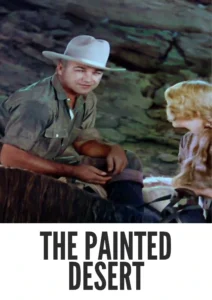The Painted Desert (1931) Colorized: Gable’s Early Western – Now in Vibrant Color!

Discover Clark Gable in a thrilling early role with The Painted Desert (1931), a classic Western now available in a beautifully colorized HD version. This film showcases a tale of friendship, rivalry, and survival amidst the stunning landscapes of the American West.
The Painted Desert (1931) Movie Storyline: Friendship and Rivalry in the Wild West
The Painted Desert tells the story of Bill Holbrook (William Boyd), a rancher who discovers a baby, Davey, in the desert and raises him as his own . Years later, Davey (Clark Gable) is a young man, and Bill’s peaceful life is disrupted by the arrival of a railroad company, led by Jeff Cameron (J. Farrell MacDonald), and his daughter, Mary Ellen (Helen Twelvetrees) .A rivalry develops between Bill and Jeff over land rights, and Davey finds himself caught in the middle . Further complicating matters, both Davey and his friend, Cash Hollett (Raymond Hatton), fall in love with Mary Ellen, leading to further conflict and testing the bonds of friendship and loyalty .
Cast of The Painted Desert (1931): Gable, Boyd, and Twelvetrees Lead the Way
- William Boyd as Bill Holbrook
- Clark Gable as Davey, as an Adult
- Helen Twelvetrees as Mary Ellen Cameron
- J. Farrell MacDonald as Jeff Cameron
- Raymond Hatton as Cash Hollett
Genre and Themes: A Western with Friendship, Romance, and Land Disputes
The Painted Desert is a Western film that explores themes of friendship, rivalry, love, greed, and the clash between tradition and progress in the American West .
The Painted Desert (1931): An Early Gable Role in a Transitioning Era
Released in 1931, The Painted Desert is notable for featuring Clark Gable in one of his early roles, before he became a major star . The film also reflects the transition from silent films to sound, with some sources noting it contains early color sequences [Some sources mention early color sequences, though this may need verification]. It was based on a novel by Oliver La Farge.
The Colorization Process: Bringing the West to Life with Modern Techniques
This colorized version of The Painted Desert (1931) was created by [Your Company Name], a company specializing in classic film restoration and colorization. Our goal was to enhance the visual experience and breathe new life into this classic Western.Our Process:
- Advanced AI Algorithms: Employing AI, we created beautiful color palettes.
- Careful Adjustments: Trained artists carefully reviewed each scene, making adjustments.
- Respect for the Original Film: Our skilled workers ensured that our colorizing efforts remained faithful to the feel of the original.
Technical Details: Download The Painted Desert (1931) in Colorized HD
- Original Release: 1931
- Director: Howard Higgin
- Starring: William Boyd, Clark Gable, Helen Twelvetrees
- Runtime: Approx. 83 minutes
- Language: English
- Download Format: MP4
- Resolution: HD (1080p)
- Compatibility: Compatible with modern devices
- Audio: Restored and enhanced
Why Watch the Colorized Version of The Painted Desert (1931)?
Experience Clark Gable in a newly colorized film and revel in the beauty of the landscape.
Download The Painted Desert (1931) Colorized in HD Today!
FAQs
Q: What is The Painted Desert (1931) about?
A: A man raises a baby in the desert, and years later, the arrival of a railroad leads to conflict and romance.
Q: Was Clark Gable already famous when he made this film?
A: The Painted Desert was one of Gable’s earlier roles before stardom.
Q: Where was this film shot?
A: It was shot in California and Arizona .











